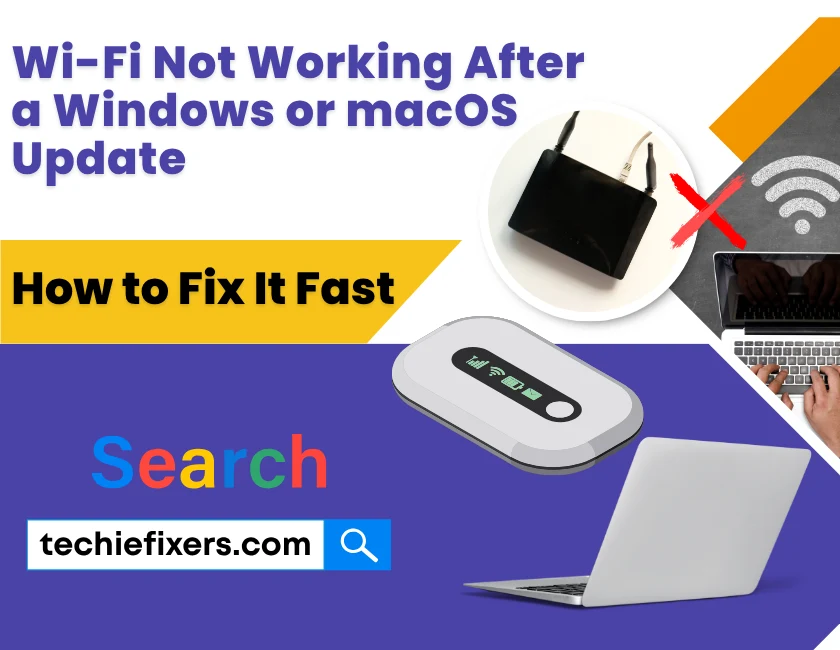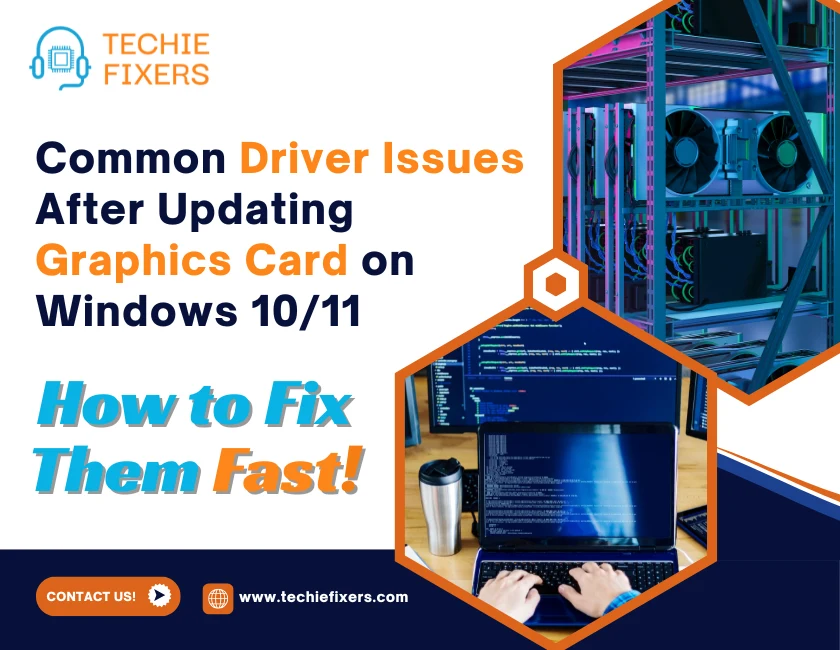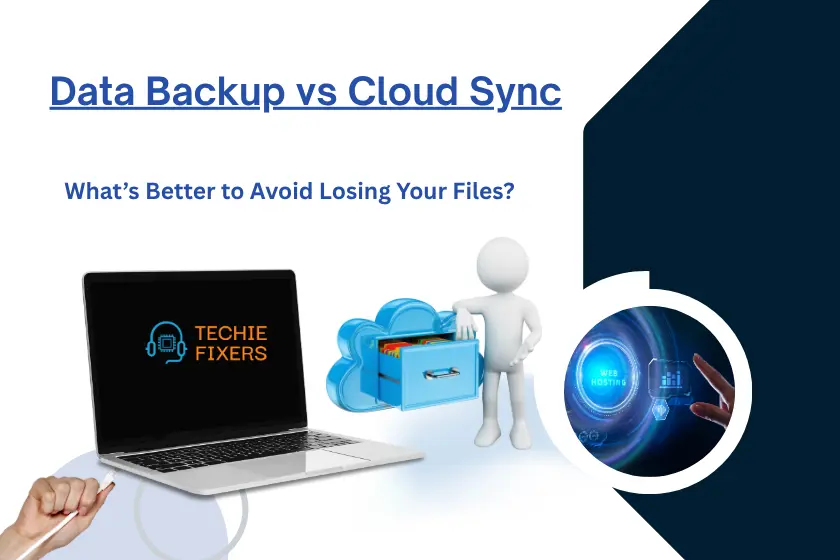We’ve all been there you install a new update on your Windows PC or Mac, expecting smoother performance, and suddenly… no Wi-Fi. Frustrating, right?
Wi-Fi not working after a Windows or macOS update is one of the most searched tech problems. Whether you rely on internet for work, school, or Netflix binges, losing connection can throw your day into chaos. But don’t worry we’re breaking down the real reasons behind this issue and showing you how to fix it step-by-step.
Quick Fixes Ahead: This guide is packed with easy, practical solutions for both Windows and macOS users no tech degree required.
Why Wi-Fi Issues Happen After a System Update
Before diving into solutions, let’s understand what’s really happening. System updates are supposed to fix bugs and improve performance but sometimes they accidentally cause new problems.
Here’s why your Wi-Fi stopped working after an update:
- Driver conflicts: Updates might install incorrect or incompatible network drivers.
- Changed network settings: Updates can reset or alter your saved Wi-Fi preferences.
- Firewall or security blocks: New system security settings might block Wi-Fi access.
- Power management tweaks: Some updates change power-saving modes that affect your network card.
Quick Checks Before You Dive Into Fixes
Let’s rule out the basics first. These steps might seem simple, but they often solve the problem instantly:
- Restart everything: Reboot your PC or Mac and your Wi-Fi router.
- Check other devices: If other devices can connect, the issue is with your computer.
- Toggle Airplane mode: Accidentally enabled? Disable it.
- Try another Wi-Fi network: If it works elsewhere, the problem is likely with your home connection.
Still stuck? Let’s move to system-specific fixes.
Fixes for Wi-Fi Not Working on Windows After an Update
If your Wi-Fi issue started after a Windows update, here are your go-to solutions:
1. Run the Windows Network Troubleshooter
- Go to Settings > System > Troubleshoot > Other troubleshooters.
- Click on Internet Connections and follow the prompts.
- Windows will try to detect and fix network problems automatically.
2. Reinstall or Roll Back Your Wi-Fi Driver
- Press
Win + X→ choose Device Manager. - Find Network adapters and right-click your Wi-Fi device.
- Select Properties > Driver tab → click Roll Back Driver (if available).
- Or uninstall it and restart your PC—Windows will reinstall the correct version.
3. Reset Network Settings
- Go to Settings > Network & Internet > Advanced network settings.
- Select Network reset. This will remove and reinstall all network adapters.
4. Disable Power Saving on Network Adapter
- In Device Manager, right-click your Wi-Fi adapter → Properties > Power Management.
- Uncheck Allow the computer to turn off this device to save power.
5. Flush DNS and Reset TCP/IP
- Open Command Prompt as Administrator.
- Type:pgsqlCopyEdit
netsh winsock reset netsh int ip reset ipconfig /release ipconfig /renew ipconfig /flushdns - Press Enter after each line. Then restart your PC.
These steps resolve most Windows Wi-Fi not working after update issues.
Fixes for Wi-Fi Not Working on macOS After an Update
Apple users also face Wi-Fi issues after macOS updates, especially after major releases like Sonoma or Monterey. Here’s how to get back online:
1. Forget and Reconnect to Your Wi-Fi
- Go to System Settings > Network > Wi-Fi.
- Click Details next to your network → select Forget This Network.
- Reconnect and re-enter your password.
2. Reset NVRAM/PRAM and SMC
Sometimes stored settings can cause connectivity issues.
- Shut down your Mac.
- Turn it on and immediately press and hold Option + Command + P + R for about 20 seconds.
- For M1/M2 Macs, just restart; NVRAM resets automatically.
3. Create a New Network Location
- Go to System Settings > Network.
- Click the three-dot menu and choose Add Location.
- Name it, click Done, then reconfigure your Wi-Fi.
4. Renew DHCP Lease and DNS
- In Wi-Fi settings, click Details > TCP/IP tab.
- Click Renew DHCP Lease.
- Under DNS, try adding Google DNS:
8.8.8.8and8.8.4.4.
5. Delete Wi-Fi Preference Files (Advanced)
- Open Finder > Go to Folder:
/Library/Preferences/SystemConfiguration/. - Delete these files:
com.apple.airport.preferences.plistcom.apple.network.identification.plistNetworkInterfaces.plist
- Restart your Mac.
These steps often resolve macOS Wi-Fi problems after update, especially if caused by misconfigured profiles.
Advanced Fixes for Tech-Savvy Users
If nothing else works, try these more technical options:
Modify IP Settings
Set a static IP manually or adjust DNS settings to a reliable public server.
Use Command Line Tools
For Windows:
bashCopy
Edit
netsh wlan show profiles
Delete and recreate profiles.
For macOS:
Use Terminal to clear caches or renew system configurations.
System Restore or Time Machine
If the update completely broke your Wi-Fi and nothing fixes it, restore your system:
- Windows: Use System Restore.
- macOS: Use Time Machine to go back before the update.
When to Contact Support or Visit a Technician
Tried everything and still no Wi-Fi? It could be a hardware issue. Here’s how to tell:
- Your device doesn’t detect any networks at all.
- Wi-Fi disappears from settings entirely.
- You see error codes like “No hardware installed” (Mac) or Code 10/43 (Windows).
At this point:
- Contact Apple or Microsoft support.
- Visit a local technician to check your Wi-Fi card.
How to Prevent Future Wi-Fi Issues After Updates
Avoiding the problem is better than fixing it, right? Here’s how:
Keep Drivers & OS Synced
- Update Wi-Fi drivers right after an OS update.
- Don’t skip optional driver updates in Windows Update.
Use Official Update Channels
- Avoid beta versions or third-party tools that may not be stable.
Backup Before Updates
- Use System Restore on Windows or Time Machine on macOS.
Pro tip: Save your Wi-Fi network name and password in a password manager so reconnecting is quick.
Final Tips to Stay Connected
While troubleshooting, here are some ways to stay online:
- Use Ethernet: A wired connection can keep you productive while Wi-Fi is down.
- Use USB Wi-Fi Adapter: Cheap and effective, especially if your internal adapter fails.
- Tether from your phone: Use mobile hotspot as a temporary internet source.
FAQs: Wi-Fi Not Working After an Update
1. Why does my Wi-Fi stop working after a Windows or macOS update?
This usually happens due to incompatible drivers, altered settings, or security restrictions. Updates may reset network configurations, leading to disconnection.
2. How do I roll back a Wi-Fi driver in Windows?
Open Device Manager > Network Adapters > Properties > Driver and select Roll Back Driver. If the option is unavailable, uninstall and restart to reinstall it.
3. What is the safest way to reset network settings?
On Windows, go to Settings > Network Reset. On Mac, forget the network or delete config files under /SystemConfiguration/. Always back up first.
4. Can my firewall or antivirus block Wi-Fi after an update?
Yes. Some security apps update rules that might interfere with connectivity. Temporarily disable them to test. If Wi-Fi works, adjust settings or switch software.
5. Is it safe to delete Wi-Fi profiles or preferences?
Yes as long as you know your Wi-Fi password. Removing old profiles can fix conflicts, especially on macOS.




